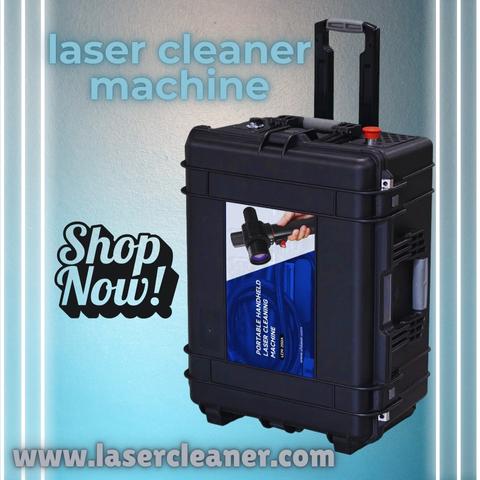Laser Cleaner Machine: Revolutionizing Surface Cleaning Across Industries

In the fast-paced world of industrial maintenance and manufacturing, efficiency, precision, and sustainability are more critical than ever. Among the tools transforming how industries approach cleaning and surface preparation, the laser cleaner machine has emerged as a game-changer. This technology is reshaping traditional cleaning methods, offering a level of control and effectiveness that conventional approaches struggle to match.
A laser cleaner machine operates on the principle of laser ablation, where high-intensity laser pulses are directed onto a surface to remove contaminants, rust, paint, or other unwanted coatings without damaging the underlying material. Unlike abrasive or chemical cleaning methods, laser cleaning is non-contact, minimizing wear and tear on surfaces and tools. This precision ensures that even the most delicate parts in aerospace, automotive, electronics, and heavy machinery industries can be cleaned with confidence.
The versatility of laser cleaner machines allows them to tackle a wide range of cleaning tasks. In manufacturing plants, they are used to remove oxidation layers from metal parts, preparing them for further processing such as welding, coating, or assembly. In automotive repair and restoration, laser cleaning machines efficiently remove rust from vehicle frames, engine parts, and metal components without requiring harsh chemicals or sanding. The electronics industry benefits from the ability to clean circuit boards and precision components, where traditional methods may cause damage or leave residues.
One of the key drivers behind the adoption of laser cleaner machines is their environmental impact. Traditional cleaning methods often rely on solvents, acids, or abrasive materials that produce chemical waste and require proper disposal. Laser cleaning eliminates these hazards, offering a green alternative that reduces chemical exposure, water usage, and waste production. This aspect makes it particularly appealing to companies striving for sustainability and compliance with environmental regulations.
Operational efficiency is another factor that has accelerated the popularity of laser cleaner machines. With adjustable power levels and pulse frequencies, operators can tailor the laser to different surface types and contamination levels, ensuring faster processing times while maintaining precision. Automation integration is also possible, allowing laser cleaning systems to be installed on robotic arms or production lines, providing consistent results on a large scale. This combination of speed and accuracy contributes to significant cost savings over time, especially when compared to labor-intensive traditional methods.
Maintenance and safety are crucial considerations in industrial environments, and laser cleaner machines address both effectively. Because the process is non-contact, there is minimal mechanical wear, reducing the frequency of machine maintenance. Additionally, modern systems come equipped with safety enclosures, protective housings, and fume extraction systems, ensuring operator safety and compliance with workplace standards. This reduces the risk of accidents associated with chemical exposure or abrasive cleaning tools.
Industries such as aerospace, automotive, shipbuilding, and heavy equipment manufacturing have widely adopted laser cleaner machines for their ability to handle complex and irregular surfaces. In aerospace applications, precision cleaning of turbine blades, landing gear components, and structural parts is critical for safety and performance. Laser cleaning ensures contaminants, oxide layers, and residues are removed without altering the material properties, which is crucial for high-stress components. In shipbuilding and metal fabrication, laser cleaning machines provide a faster, more uniform removal of rust and old paint from hulls and structural beams, allowing subsequent coatings to adhere more effectively.
The technology is also making waves in niche applications where traditional methods fail. Restoration of historical artifacts, removal of graffiti from public spaces, and cleaning of delicate instruments in laboratories can all benefit from laser cleaning. By adjusting the intensity and duration of the laser pulse, operators can remove unwanted layers without damaging the original surface, preserving the integrity and value of precious materials.
Global market trends indicate a growing demand for laser cleaner machines, driven by industrial modernization, sustainability goals, and the push for more efficient manufacturing practices. As companies continue to invest in advanced machinery, laser cleaning is becoming a standard in sectors where precision, environmental responsibility, and operational efficiency are top priorities. Training programs and operator education ensure that professionals can fully leverage the capabilities of these machines while maintaining safety and quality standards.
In summary, the laser cleaner machine represents a significant advancement in the way industries approach surface cleaning and maintenance. Its combination of precision, versatility, and eco-friendliness makes it a tool that is transforming production processes and maintenance practices worldwide. From heavy industry to delicate restoration work, laser cleaning delivers results that are difficult to achieve with traditional methods. Its ability to save time, reduce waste, and improve surface preparation is setting new standards for operational excellence.
Final Thoughts
The laser cleaner machine is no longer a futuristic concept but a practical solution embraced across industries for its efficiency and precision. As technology continues to advance, the applications for laser cleaning will only expand, creating new opportunities for innovation and sustainable practices in manufacturing, restoration, and maintenance. Companies that invest in this technology are positioning themselves at the forefront of modern industrial processes, achieving cleaner results faster and more responsibly than ever before.
- Art
- Causes
- Crafts
- Dance
- Drinks
- Film
- Fitness
- Food
- Jeux
- Gardening
- Health
- Domicile
- Literature
- Music
- Networking
- Autre
- Party
- Religion
- Shopping
- Sports
- Theater
- Wellness



